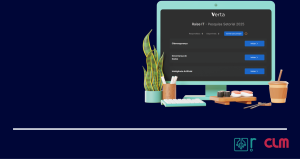This article explores the critical role of Identity Governance and Administration in achieving ISO 27001:2022 compliance, emphasizing the importance of robust access controls, secure authentication, and automated identity lifecycle management. It details specific ISO 27001 controls relevant to IGA, such as Segregation of Duties, Access Control, and Privileged Access Rights, and highlights how adherence to these controls enhances organizational security. The article also addresses common challenges in achieving compliance. It approaches comprehensive services designed to guide organizations through the complexities of IGA implementation, ensuring enhanced security, operational efficiency, and trust with customers and stakeholders.
By Fabio Sobiecki, Identity Security Strategist, Raise IT
What is the significance of ISO/IEC 27001:2022 for information security?

ISO/IEC 27001:2022, the latest iteration of the globally recognized standard for Information Security Management Systems (ISMS), is a proactive tool published by the International Organization for Standardization (ISO) and the International Electrotechnical Commission (IEC). This standard equips organizations with a comprehensive framework to establish, implement, maintain, and continually improve their information security management practices.
By adhering to ISO 27001, organizations can systematically identify and manage information security risks, ensuring confidentiality, integrity, and availability of their information assets. This is particularly crucial for companies that seek to be secure, where cyber threats are increasingly sophisticated and pervasive. Implementing this standard enhances an organization’s resilience against cyberattacks and demonstrates a commitment to protecting sensitive data, fostering trust among customers, partners, and stakeholders.
Furthermore, compliance with ISO 27001 assists organizations in meeting legal and regulatory requirements related to information security, reducing the risk of penalties and reputational damage. In essence, ISO 27001 is a strategic tool that enables organizations to proactively manage information security risks and align their security objectives with business goals. Regular reviews are an essential part of this process, providing reassurance and maintaining the organization’s security.
The role of Identity Governance and Administration in achieving compliance

Identity Governance and Administration (IGA) is critical in achieving and maintaining compliance with ISO 27001. It is the cornerstone for managing and securing sensitive information and system access.
IGA ensures that the right individuals have access to the right resources at the right time, aligning access privileges with business needs while minimizing security risks. By automating and centralizing identity-related processes, IGA not only enables organizations to enforce consistent access policies and monitor user activities but also significantly reduces operational overhead.
Prompt detection and response to unauthorized access attempts are facilitated, and practical IGA implementations provide the necessary framework to address key ISO 27001 controls. This helps organizations demonstrate adherence to regulatory requirements and industry best practices, improving security posture and enhancing stakeholder trust, making the organization more efficient and productive.
Understanding ISO 27001 Controls Relevant to IGA

5.3 Segregation of Duties: Ensuring that critical tasks are divided among different individuals to prevent fraud and errors
Segregation of Duties (SoD) is a basis internal control principle designed to mitigate the risk of fraud, errors, and conflicts of interest within an organization. Control 5.3 of ISO 27001 emphasizes dividing responsibilities for critical tasks among individuals. The fundamental concept behind SoD is to establish checks and balances, ensuring that no single person has unchecked authority over a process or transaction from initiation to completion. When multiple individuals are involved, each acts as a safeguard, reviewing and overseeing the actions of others. This mutual oversight makes it significantly more difficult for individuals to commit fraud or make errors without detection.
For example, in financial transactions, the person who authorizes a payment should not be the same person who initiates it or reconciles bank statements. Similarly, in IT, the administrator who grants access rights to a system should differ from the one who audits access logs. In procurement, the person who approves purchase orders should not be the same as the one who receives the goods or pays the invoices. Maintaining compliance with the Segregation of Duties control is crucial for fraud prevention, error reduction, asset protection, regulatory compliance, and improved governance. SoD is one of the most effective methods for preventing internal fraud by ensuring that no single person has unchecked authority, thus reducing the risk of fraudulent activities. Additionally, it helps to catch mistakes through multiple layers of review, protecting an organization’s assets, including financial resources, intellectual property, and sensitive data. Organizations can enhance their security posture and reduce risks by diligently implementing and maintaining Segregation of Duties.
5.15 Access Control: Implementing measures to restrict access to information based on business needs
Access Control, as stipulated in ISO 27001 control 5.15, is a critical component of information security, serving as a foundational layer in protecting an organization’s sensitive data and resources. Implementing robust access control measures means establishing policies and procedures that meticulously define who can access what information, when, and under what conditions. The primary goal is to restrict access to authorized personnel only, ensuring that individuals are granted the minimum level of access necessary to perform their job functions. This principle, often referred to as ‘least privilege’, is essential in minimizing the potential damage from internal and external threats.
Effective access control systems involve a multifaceted approach that includes identifying users, authenticating their identities, authorizing their access rights, and continuously monitoring and auditing their activities. This typically involves implementing mechanisms such as user IDs and passwords, multi-factor authentication, role-based access control (RBAC), and regular access reviews. By carefully managing access rights, organizations can prevent unauthorized individuals from accessing sensitive data, modifying critical system settings, or disrupting essential business processes. Access control is vital in mitigating the risk of data breaches, insider threats, and other security incidents that could compromise information confidentiality, integrity, and availability. It ensures that only authorized users can access and manipulate data, reducing the likelihood of data leakage, corruption, or misuse.
Moreover, access control is not merely a technical implementation; it also encompasses administrative and physical controls. Policies and procedures must be in place to govern access requests, approvals, and terminations. At the same time, physical security measures, such as locks, alarms, and surveillance systems, must protect physical access to sensitive areas. Regular audits of access logs and user permissions are essential for identifying and addressing anomalies or potential security vulnerabilities. By integrating access control into the broader information security management system, organizations can create a secure and controlled environment that supports business operations while safeguarding valuable assets.
5.16 Identity Management: Managing the lifecycle of identities to ensure accurate and timely access
Identity Management, as outlined in ISO 27001 control 5.16, is a critical process focused on managing the entire lifecycle of digital identities within an organization, ensuring accurate and timely access to resources. Effective identity management involves a comprehensive approach to creating, maintaining, and removing user identities and managing their associated access rights. This includes provisioning new user accounts when employees join the organization, updating user profiles as their roles change, and deprovisioning accounts promptly when employees leave or no longer require access. The aim is to ensure that every user has a unique and verified digital identity that accurately reflects their current role and responsibilities within the organization.
A well-implemented identity management system typically includes centralized repositories for storing user information, automated workflows for managing user access requests and approvals, and robust auditing capabilities to track user activities. By centralizing identity data, organizations can ensure consistency and accuracy across different systems and applications, reducing the risk of errors and unauthorized access. Automated workflows streamline granting and revoking access rights, enabling IT departments to respond quickly to changing business needs while maintaining security. Regular audits of identity data and access privileges help to identify and address any discrepancies or potential security vulnerabilities.
Moreover, identity management is not solely a technical function but requires strong governance and policy frameworks. Organizations must establish clear policies and procedures for managing user identities, including guidelines for password management, access requests, and account termination. Regular training and awareness programs are essential to educate employees about their responsibilities in protecting their digital identities and following security best practices. By integrating identity management into the overall information security management system, organizations can create a secure and efficient environment that supports business operations while minimizing the risk of unauthorized access and data breaches.
5.17 Authentication Information: Protecting authentication credentials to prevent unauthorized access
Authentication Information, as addressed by ISO 27001 control 5.17, is a vital element of information security that centers on safeguarding the credentials used to verify user identities, thereby preventing unauthorized access to systems and data. This control recognizes that authentication credentials, such as passwords, PINs, biometric data, and security tokens, are prime targets for attackers seeking illicit entry into an organization’s network and resources. Protecting these credentials requires a multi-faceted approach encompassing strong password policies, secure storage mechanisms, and robust authentication methods.
Organizations must implement stringent password policies that mandate regularly changing strong, unique passwords. These policies should also prohibit the reuse of previous passwords and encourage the use of password managers to store and manage credentials securely. Authentication credentials should be stored using strong encryption algorithms to protect them from unauthorized disclosure in case of a data breach. Furthermore, organizations should implement multi-factor authentication (MFA) whenever possible, requiring users to provide two or more verification factors before granting access to sensitive systems or data. This significantly reduces the risk of unauthorized access, even if one authentication factor is compromised.
In addition to technical measures, organizations should provide regular training and awareness programs to educate employees about protecting their authentication credentials. Employees should be trained to recognize phishing attacks, avoid using public Wi-Fi networks for sensitive transactions, and immediately report suspicious activity. Regular audits of authentication logs can help identify and address potential security vulnerabilities, such as weak passwords or unauthorized access attempts. By diligently protecting authentication information, organizations can significantly reduce the risk of unauthorized access and data breaches, safeguarding their sensitive data and maintaining the integrity of their systems.
5.18 Access Rights: Regularly reviewing and adjusting access rights to maintain security
Access Rights, as mentioned by ISO 27001 control 5.18, are critical to maintaining a robust security posture by ensuring that an organization regularly reviews and adjusts user permissions to align with their current roles and responsibilities. The principle behind this control recognizes that access requirements evolve as employees change roles, projects conclude, or business needs shift. Therefore, it’s essential to periodically reassess who has access to what resources and to make adjustments accordingly, removing unnecessary or outdated permissions that could create security vulnerabilities. Regular reviews of access rights help to ensure that the principle of least privilege is upheld, where users are granted only the minimum level of access necessary to perform their job functions, thereby reducing the potential impact of insider threats and unauthorized access.
The process of reviewing and adjusting access rights typically involves several key steps. First, organizations must establish a clear policy defining access review frequency and scope. These reviews should involve IT personnel and business stakeholders who can validate the appropriateness of user permissions. Second, organizations should use automated tools and systems to generate reports of user access rights and identify any anomalies or discrepancies. Third, organizations must have a well-defined process for revoking or modifying access rights based on the findings of the access reviews. This may involve updating user profiles, disabling accounts, or reassigning permissions.
The importance of regularly reviewing and adjusting access rights cannot be overstated. Neglecting this control can build up unnecessary permissions, creating a significant security risk. Users with excessive access rights may be able to access sensitive data or systems irrelevant to their current job duties, increasing the likelihood of data breaches or insider threats. Moreover, outdated access rights can make tracking and monitoring user activities difficult, hindering incident response efforts. By proactively managing access rights, organizations can minimize the potential for unauthorized access, protect sensitive data, and maintain a strong security posture.
8.2 Privileged Access Rights: Managing and monitoring elevated access to critical systems
Privileged Access Rights, as highlighted in ISO 27001 control 8.2, represent a critical area of focus for any organization serious about safeguarding its most sensitive systems and data. These rights provide elevated levels of access and control over critical IT infrastructure, applications, and information assets, typically reserved for administrators and specialized technical staff. Because privileged accounts possess the power to make significant changes, bypass security controls, and access highly confidential information, they represent a substantial security risk if compromised or misused. Therefore, managing and monitoring privileged access rights is paramount to maintaining an organization’s information’s confidentiality, integrity, and availability.
Effective management of privileged access rights involves implementing robust controls and processes to ensure that these elevated privileges are only granted to authorized individuals, used for legitimate business purposes, and closely monitored for any signs of misuse or abuse. This includes establishing clear policies and procedures for requesting, approving, and granting privileged access and implementing strong authentication mechanisms, such as multi-factor authentication, to verify the identities of privileged users. Organizations should also use privileged access management (PAM) solutions to manage and control privileged accounts centrally, enforce least privilege principles, and monitor privileged user activity in real-time.
The importance of managing and monitoring privileged access rights cannot be overstated. A compromised privileged account can provide attackers with unrestricted access to an organization’s most critical systems and data, allowing them to steal sensitive information, disrupt business operations, or even completely take over the network. Insider threats, whether malicious or unintentional, also pose a significant risk when privileged users have excessive or unchecked access rights. By implementing strong controls over privileged access, organizations can significantly reduce the risk of these types of security incidents, protecting their valuable information assets and maintaining the trust of their customers and stakeholders.
8.5 Secure Authentication: Implementing robust authentication mechanisms to verify user identities
Secure Authentication, as emphasized by ISO 27001 control 8.5, is a cornerstone of information security. It represents the critical process of verifying the identity of users attempting to access systems, applications, and data. Implementing robust authentication mechanisms is essential to prevent unauthorized access, protect sensitive information, and maintain the integrity of an organization’s IT infrastructure. This control recognizes that weak or easily compromised authentication methods can provide attackers with a gateway to bypass security controls and access valuable assets.
Effective secure authentication involves a multi-layered approach beyond simple username and password combinations. Organizations should implement strong password policies that mandate the use of complex, unique passwords that are regularly changed. Multi-factor authentication should be implemented whenever possible, requiring users to provide two or more verification factors, such as a password, a one-time code sent to their mobile device, or a biometric scan. This significantly reduces the risk of unauthorized access, even if one authentication factor is compromised. Organizations should also consider implementing adaptive authentication techniques that dynamically adjust the level of security based on the user’s location, device, and behavior.
The importance of secure authentication cannot be overstated. It is the first defense against unauthorized access, preventing attackers from impersonating legitimate users and gaining access to sensitive systems and data. Attackers can easily exploit weak authentication methods such as phishing, password cracking, and social engineering. By implementing robust authentication mechanisms, organizations can significantly reduce the risk of these types of attacks, protecting their valuable information assets and maintaining the trust of their customers and stakeholders. Moreover, secure authentication is essential for complying with various regulations and industry standards that require organizations to implement strong access controls to protect sensitive data.
The Importance of Implementing These Controls

Adhering to these ISO 27001 controls significantly enhances an organization’s security posture by establishing a structured and comprehensive framework for protecting sensitive information and systems. By implementing controls like Segregation of Duties, Access Control, Identity Management, and Secure Authentication, organizations can minimize the risk of data breaches, insider threats, and other security incidents. These controls ensure that only authorized individuals have access to the right resources at the right time, reducing the potential for unauthorized access, data leakage, or misuse. Moreover, adherence to these controls fosters a culture of security awareness and accountability throughout the organization, promoting proactive risk management and continuous improvement.
Aligning with market best practices, even without formal ISO 27001 certification, provides numerous benefits. By adopting these practices, organizations can improve their security posture, enhance their reputation, and gain a competitive advantage. Adhering to best practices demonstrates a commitment to protecting sensitive information and maintaining customer trust. It also helps organizations to meet regulatory requirements and avoid potential legal liabilities. Furthermore, aligning with market best practices can improve operational efficiency, reduce costs, and enhance overall business performance.
However, achieving compliance with these controls is not without its challenges. Organizations often face resource constraints, a lack of expertise, and complex technical environments. Implementing these controls may require significant technological, training, and personnel investments. Organizations may struggle to integrate these controls into their business processes and systems. Overcoming these challenges requires a strategic approach, strong leadership support, and a commitment to continuous improvement.
Challenges in Achieving Compliance

Achieving compliance with IGA-related controls presents a unique set of challenges for organizations, often from internal and external factors. One of the most common obstacles is the complexity of implementing and maintaining these controls across diverse IT environments. Organizations frequently grapple with integrating IGA solutions into existing legacy systems, cloud platforms, and disparate applications, which can require significant customization and configuration. This complexity is further compounded by the need to address evolving regulatory requirements and emerging security threats, demanding continuous adaptation and refinement of IGA processes.
Resource constraints and a lack of expertise also pose significant challenges to achieving compliance. Implementing and managing IGA-related controls requires skilled personnel with expertise in identity management, access governance, and security technologies. Organizations often struggle to find and retain qualified professionals, particularly in the face of budget limitations and competing priorities. Without adequate resources and expertise, organizations may lack the capacity to implement and maintain IGA controls effectively, leading to gaps in security and compliance. This can increase vulnerability to data breaches, regulatory penalties, and reputational damage.
How can we assist you with this goal?

Raise IT offers comprehensive services designed to guide organizations through the complexities of planning and implementing Identity Governance and Administration best practices, ultimately facilitating compliance with ISO 27001. Our approach begins with a thorough assessment of your current IGA landscape, identifying gaps, vulnerabilities, and areas for improvement in alignment with ISO 27001 controls. Based on this assessment, Raise IT develops a customized roadmap tailored to your organization’s unique needs, outlining specific steps for implementing and optimizing IGA processes. This includes defining clear roles and responsibilities, establishing robust access control policies, implementing secure authentication mechanisms, and automating identity lifecycle management.
To help organizations achieve compliance with specific ISO 27001 controls related to IGA, Raise IT provides tailored solutions that address the challenges of Access Rights (5.18), Privileged Access Rights (8.2), and Secure Authentication (8.5), among others. We offer solutions for automating access reviews for Access Rights, ensuring user permissions are regularly validated and adjusted based on their current roles and responsibilities. We implement robust PAM solutions for Privileged Access Rights that control and monitor elevated access to critical systems. For secure authentication, we assist in deploying MFA and adaptive authentication techniques to verify user identities and prevent unauthorized access. Raise IT empowers organizations to establish a strong foundation for information security, fostering a culture of accountability and continuous improvement, ensuring that your sensitive data remains protected and compliant with industry standards.
The role of IGA on ISO 27001

In conclusion, IGA is critical in achieving and maintaining compliance with ISO 27001, ensuring that organizations can effectively manage access to sensitive information and systems. Organizations can significantly reduce the risk of data breaches, insider threats, and regulatory penalties by adhering to IGA best practices, such as robust access controls, secure authentication mechanisms, and automated identity lifecycle management. These measures protect valuable assets and foster a culture of security awareness and accountability throughout the organization.
We encourage all organizations to adopt these IGA best practices, regardless of whether they pursue formal ISO 27001 certification. Embracing these practices demonstrates a commitment to protecting sensitive information, enhancing operational efficiency, and building trust with customers and stakeholders. By prioritizing IGA and continuously improving your security posture, you can create a more resilient environment supporting long-term business success and compliance with evolving regulatory requirements.
Ready to strengthen your organization’s security posture and achieve compliance with ISO 27001 through effective Identity Governance and Administration? Contact Raise IT today for expert guidance and support in implementing IGA best practices tailored to your needs. Our experienced team is ready to help you navigate the complexities of IGA and build a robust security framework that protects your valuable information assets. Reach out now to schedule a consultation and take the first step towards enhanced security and compliance!



